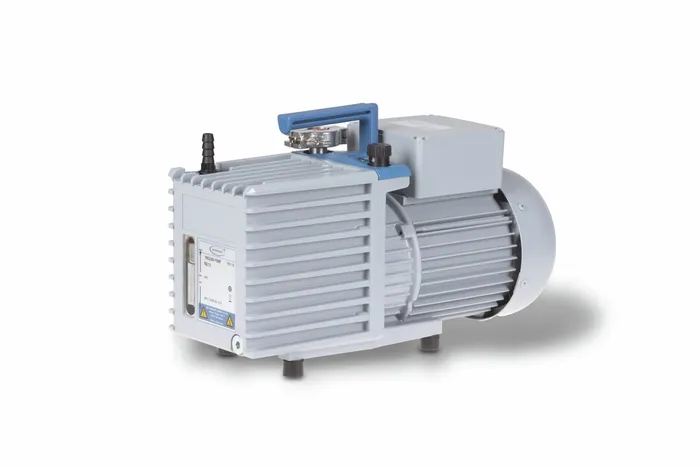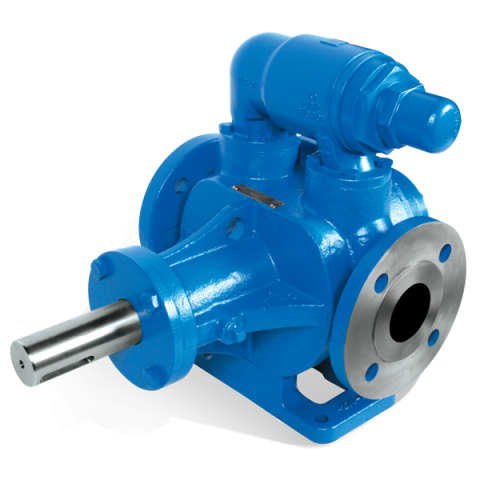Product Description
SRV0063 Single-stage,Oil-lubricated rotary vane vacuum pump,rotary piston pump,rotary vane blower
Pransch air rotary vane pumps have been the most popular pumps for generating low and medium vacuum for many years now. They are sturdy and have a long life, whether they are used as backing pumps to generate the backing pressure called for by turbopumps, or as a single standalone pump. Rotary vane pumps belong to the family of displacement pumps and convey a virtually steady low-pulsation suction volume flow, irrespective of the type of gas used. They work on the principle of an eccentrically supported rotor revolving in a housing, and have 2 or more movable vanes. Every CHINAMFG rotary vane vacuum pump is oil-lubricated. Special vacuum oils, also known as operating fluids, are responsible for insulating and lubricating components, resulting in very low final pressures. The oil lubrication also ensures an extremely long lifetime, even in continuous operation.
- For industrial applications – very powerful
- Three-phase universal motor available, allowing an almost CHINAMFG network coverage
- Integrated oil mist separator with highest degree of separation
- Special vane material for a long service life
- Main application fields:
metal polishing machines, vacuum welding of precious metals, packing machines, glass and marble lifting systems, vacuum bottling machines, packaging machines, loading and paper feeding, labelling, equipment for suction handling, automatic machines, machines for vacuum packed food-processing and mixing, vacuum thermal moulding, garage equipment, centralised vacuum plant installations.
| Technical data | Frequency | SRV 0063 |
| Pumping Speed | 50Hz | 63m3/h |
| 60Hz | 76m3/h | |
| Ultimate pressure | mbar | 0.1 |
| Diameter | “ | G 1 ¼” / G 1 ¼” |
| Voltage | 50Hz | 220-240/345-415v |
| 60Hz | 220-275/380-480v | |
| Nominal motor rating | Kw | 2.2 |
| Current | 50Hz | 8.5/4.9A |
| 60Hz | 9.2/5.3A | |
| Nominal speed | rpm | 1405/1720 |
| Sound | dB(A) | 63 |
| Oil (max) | L | 2 |
| Weight(w/o oil) | Kg | 55 |
Single-stage rotary vane pumps from CHINAMFG Air have long been some of the most widely used products for processes in the low and medium vacuum range. Their long life and pumping speed, irrespective of the gas used, are the outstanding properties of this pump.
Typical applications are found in widely ranging sectors:
- Analytics (mass spectrometry, electron microscopy)
- Coating technology (surface protection, decorative films, display units, monitor screens)
- Vacuum metallurgy (vacuum soldering, vacuum sintering, vacuum alloys, CHINAMFG construction)
- Leak detection technology (vacuum systems, automotive tanks, airbag cartridges, packaging)
- Lighting industry (light bulb manufacture)
- Drying industry (vacuum drying, transformer drying)
/* January 22, 2571 19:08:37 */!function(){function s(e,r){var a,o={};try{e&&e.split(“,”).forEach(function(e,t){e&&(a=e.match(/(.*?):(.*)$/))&&1
| Oil or Not: | Oil |
|---|---|
| Structure: | Rotary Vacuum Pump |
| Exhauster Method: | Kinetic Vacuum Pump |
| Vacuum Degree: | Vacuum |
| Work Function: | Maintain the Pump |
| Working Conditions: | Dry |
| Customization: |
Available
|
|
|---|

What Is the Role of Lubrication in Rotary Vane Pump Operation?
Lubrication plays a critical role in the operation of a rotary vane pump, ensuring its smooth and efficient performance. Here’s a detailed explanation of the role of lubrication in rotary vane pump operation:
– Friction Reduction: The primary function of lubrication is to reduce friction between moving parts within the pump. In a rotary vane pump, the vanes slide in and out of the rotor slots as the rotor rotates. Lubrication forms a thin film between the vanes and the rotor, reducing the friction and allowing smooth movement. This friction reduction minimizes wear and tear on the vanes and rotor, contributing to the longevity of the pump.
– Seal Enhancement: Lubrication also helps in creating a tight seal between the vanes and the pump housing. The lubricant fills any gaps or imperfections, ensuring proper sealing and preventing gas or fluid leakage. This is particularly important for achieving and maintaining the desired vacuum levels in the pump. Effective sealing enhances the pump’s efficiency and performance.
– Heat Dissipation: During operation, a rotary vane pump generates heat due to the friction and compression of gases or fluids. Lubrication helps in dissipating this heat by absorbing and carrying it away from the critical components of the pump. It prevents excessive heat buildup that can lead to component damage or reduced performance. Proper lubrication ensures that the pump operates within the desired temperature range.
– Wear Protection: The lubricant forms a protective layer on the surfaces of the vanes, rotor, and other moving parts. This layer acts as a barrier, minimizing direct metal-to-metal contact and reducing wear and tear. It helps prevent damage to the vanes and rotor caused by friction and ensures the longevity of these components. Lubrication also protects against corrosion and helps maintain the overall integrity of the pump.
– Noise Reduction: Lubrication contributes to noise reduction in a rotary vane pump. The smooth movement facilitated by the lubricant minimizes vibrations and eliminates or reduces unwanted noise generated during operation. This is particularly important in applications where low noise levels are desired, such as laboratory or medical settings.
– Performance Optimization: Proper lubrication is crucial for maintaining the pump’s performance and efficiency. It ensures that the pump operates with minimal resistance and energy loss, allowing it to achieve the desired vacuum levels or fluid flow rates effectively. Lubrication helps optimize the pump’s overall performance and contributes to its reliability and effectiveness in various applications.
It’s important to note that using the correct type of lubricant specified by the pump manufacturer is essential. Different rotary vane pumps may have specific lubrication requirements, including the type of lubricant and recommended lubrication intervals. Adhering to these guidelines ensures that the lubrication effectively fulfills its role and maintains the pump’s optimal operation.

What Are the Advantages of Using Rotary Vane Pumps?
Rotary vane pumps offer several advantages that make them suitable for various applications. Here’s a detailed explanation of the advantages of using rotary vane pumps:
– Efficient Operation: Rotary vane pumps are known for their efficient operation. They provide a continuous and steady flow of gas or fluid, making them ideal for applications that require a consistent pumping action. The positive displacement mechanism ensures reliable performance, even at varying pressures and viscosities.
– Compact Design: Rotary vane pumps have a compact design, which makes them space-efficient and allows for easy installation in various systems and equipment. Their small footprint is particularly advantageous in applications where space is limited.
– Self-Priming Capability: Rotary vane pumps are typically self-priming, meaning they can evacuate air from the system and create a vacuum without the need for external priming. This feature simplifies the setup process and reduces the time and effort required to start the pump.
– Versatility: Rotary vane pumps are versatile and can handle a wide range of gases and fluids, including air, water, oil, solvents, and chemicals. This versatility makes them suitable for a diverse range of applications across industries such as manufacturing, automotive, pharmaceutical, and HVAC.
– Wide Pressure Range: Rotary vane pumps can operate effectively across a wide pressure range, from low vacuum to moderate positive pressures. They can generate both vacuum and positive pressure, making them adaptable to different process requirements.
– High Vacuum Capability: Rotary vane pumps are capable of achieving high vacuum levels, making them valuable in applications that require precise control of pressure or the creation of a vacuum environment. They can produce vacuum levels up to several millibars or even lower, depending on the specific pump design.
– Reliability and Durability: Rotary vane pumps are known for their reliability and long service life. The robust construction, coupled with proper maintenance and lubrication, ensures durability and extends the operational lifespan of the pump. They can withstand demanding operating conditions and offer consistent performance over time.
– Low Noise and Vibration: Compared to some other types of pumps, rotary vane pumps tend to operate with low noise levels and minimal vibration. This characteristic is advantageous in applications where noise reduction and smooth operation are essential, such as laboratories or residential environments.
– Easy Maintenance: Rotary vane pumps are generally easy to maintain. Routine maintenance tasks typically involve checking and replacing the vanes, inspecting and cleaning the pump chamber, and ensuring proper lubrication. Regular maintenance helps optimize pump performance and prolong its lifespan.
– Cost-Effective: Rotary vane pumps often offer a cost-effective solution for many pumping applications. They are generally more affordable compared to some other types of pumps, making them an attractive choice for budget-conscious users. Additionally, their energy efficiency contributes to cost savings in the long run.
In summary, the advantages of using rotary vane pumps include efficient operation, compact design, self-priming capability, versatility, wide pressure range, high vacuum capability, reliability and durability, low noise and vibration, easy maintenance, and cost-effectiveness. These advantages make rotary vane pumps a popular choice in various industries and applications where reliable and efficient pumping is required.


editor by Dream 2024-05-07
Leave a Reply